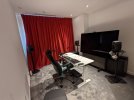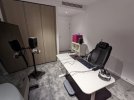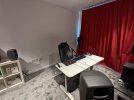ernestcarl
Major Contributor
Just in case, you may also want to try this simple phase-only EQ adjustment:

*magnitude ripple is due to the centering and tap settings -- this is in order to limit FIR delay.

It doesn't attempt to completely match the phases; however, the range should be close enough around +- 60 degrees from each other. It might even possibly give a more favorable summed response over your all pass filter, with the caveat of some potential audible pre-ringing, and this correction mainly only working at the measured MLP. My suspicion is that it's probably not really going to be a significant issue with actual music listening tests -- but, only way to know is to A/B test this...
*magnitude ripple is due to the centering and tap settings -- this is in order to limit FIR delay.
It doesn't attempt to completely match the phases; however, the range should be close enough around +- 60 degrees from each other. It might even possibly give a more favorable summed response over your all pass filter, with the caveat of some potential audible pre-ringing, and this correction mainly only working at the measured MLP. My suspicion is that it's probably not really going to be a significant issue with actual music listening tests -- but, only way to know is to A/B test this...



